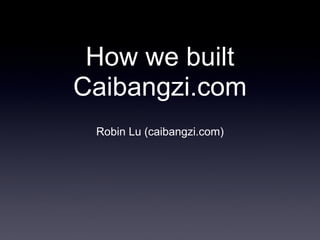How we build caibangzi.com
- 1. How we built Caibangzi.com Robin Lu (caibangzi.com)
- 2. Introduction Personal Investment Management. Tool + Community Founders: We are engineers! Technology: Ruby On Rails MySQLïžLinuxïžLighttpd ...
- 3. Topics Problems we are facing Architecture evolution of caibangzi Maintenance Q&A
- 4. Peaks! High Peak Heavy Computation Visiting Peak, Computation Peak and Cache expiration Peak are in the same time. :...(
- 5. Evolution - Start Launched at March, 2007 Hardware: 1 x 1U server 1xAMD Opteron 250, 2G Memory, 250G SATA, RAID 1 Bandwidth Shared less than 3Mbps
- 6. Evolution - Start Apache 2 + mod_proxy_balancer mongrel x 8 All in memcached caibangzi one box rails 1.1.6 MySQL 5
- 7. First Challenge May, 2007 Extremely time consuming actions blocked the site. Performance tuning Optimize Rails cache
- 8. Second Challenge August, 2007 We were running out of bandwidth Solution: Money upgrade to 5Mbps
- 9. Server upgrading High growth rate after August, 2007 Hardware upgrading in Sept. 2007 still 1 x 1U 2 x AMD 2214 2.2GHz 4G RAM
- 10. Until Sept. 2007 Apache 2 + mod_proxy_balancer mongrel x 20 Still in memcached caibangzi one box rails 1.1.6 MySQL 5
- 11. Something happened in Oct. 2007 Stock Index reached 6000 Daily pv reached 1 million Bigger challenge came
- 12. Several Changes We Made Upgrade bandwidth to 10Mbps Separate APP server and DB server Load Balancer Distributed Computation
- 13. 2 Boxes Web Server event mongrel x 30 AP memcached caibangzi P rails MySQL 5 Tianyuanji a
- 14. Load balancer Run with 2 mongrels behind balancer
- 15. Load balancer Slow actions block the others with balancer: by request Apach e by traffic HAproxy round-robin Nginx Lighttpd 1.4 Note: Nginx fixed it with âfairâ balancer later
- 16. Caibangzi Choice of Balancer Lighttpd 1.5 beta proxy-core.balancer = "sqf" http://redmine.lighttpd. net/issues/show/1362 For Rails application, choice of balancer is sometimes more important than choice of web server
- 17. More on Web Server disable keep-alive serve static files with web server instead of mongrel tune configurations according to your web server documentations
- 18. Distributed solution BackgrounDRB based on Distributed Ruby (DRB) use ruby thread high overhead during context switching very slow when concurrent connections higher than 10
- 19. Distributed solution FastBackground our own distributed computation solution based on Eventmachine simple, but fast and works for us
- 20. Rails upgrading Early of 2008, we upgraded to Rails 2.0 expired several plugins refactory to be more RESTful cookie session multi view => wap.caibangzi.com
- 21. Open API API Based on OAuth integrate caibangzi into your own sites Other APPs support several F8 clones xiaonei.com, hainei.com, UCHome
- 22. Maintenance Munin easy to use and extend Monit Crontab
- 23. With all that.... we handled: pv/day 1M rails req/day 1.8M peak rails req/sec 160 total req/day 5M peak req/sec 430 Itâs the fact. Not the capacity. Our CPU usage never goes higher than 30%
- 24. Q&A























